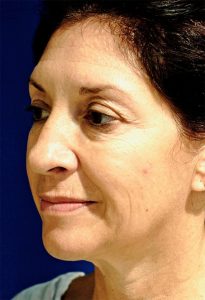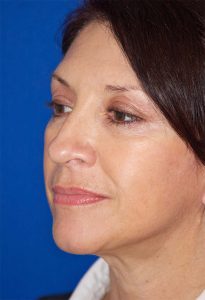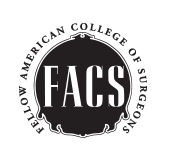Aging is inevitable. Even when someone practices healthy personal habits and avoids sun exposure, fine lines and wrinkles can creep up on them over time. Genetics also plays a role in the aging process. An individual can do as much as they can with preventative measures, but it still may not be enough to slow down the aging process. This is especially true for deep creases along the lower eyelids, loss of skin tone that creates jowls, and loose skin and fatty deposits under the chin and jaw. These facial characteristics can make a person look old, tired, and worn out.
A surgical option many opt for is facelift surgery in order to get rid of visible signs of aging on the face and neck. Facelift surgery is used to remove or reposition excess skin and fat from the face and neck to create a youthful, rejuvenated look.
Schedule Your Consultation TodayAchieved With Facelift Surgery

Reduction of Fine Lines and Wrinkles
Facelift surgery can reduce the appearance of facial aging by removing excess fat and skin. Once the remaining skin is tightened and sutured into place, fine lines and wrinkles are smoothed out, creating a more youthful and refreshed look.

Improved Facial Profile
Sagging skin around the jowls, chin, and neck area can affect a person’s overall facial profile and harmony. Once the excess tissue is removed, patients will notice their neck and chin contours complement the entire frame of the face.

Restored Confidence
A face that looks aged and worn-out can make a person feel as if they appear sloppy, causing them not to be happy with the way they look. Facelift surgery can help a person get rid of signs of aging that cause them to feel insecure. Overall, they will feel more confident with their youthful, rejuvenated facial appearance.

Personally Tailored Results
Not everyone has the same facial structure or cosmetic goals. Dr. Taylor knows everyone is unique, so he designs every facelift procedure to meet the individual’s facial anatomy and personal preferences.
What Does a Facelift Entail?
Procedure
Dr. Taylor performs most of his facelift procedures in his office operating room under mild sedation anesthesia. Occasionally, general anesthesia may be used if there is a medical indication or because of patient preference. An incision is made above the hairline by each temple and proceeds around the natural contours of the ear. Men can have their incisions made along the natural beard line. The skin is raised outward and repositioned, and the underlying muscles, fat, and connective tissues are tightened. Excess facial fat and loose, hanging skin are removed. The remaining skin is pulled tight, and the incisions are closed using fine sutures.
Dr. Taylor offers facelift variations. While a full facelift addresses the face and neck, an upper facelift can be performed for patients whose primary concerns are located above the jawline. An upper facelift does not fully tighten the neck; however, it can be performed with minimally invasive treatments like FaceTite® to improve the jawline and neck.
Procedure Combinations
Facelift surgery is commonly combined with other facial procedures. Some of these may include eyelid lift surgery, laser skin resurfacing, brow lift surgery, and volume enhancement with fat or fillers.
Additionally, Dr. Taylor commonly performs upper facelift surgery with FaceTite®. This combination is ideal for patients with significant concerns above the jawline and only minor concerns in the neck. FaceTite® is a minimally invasive skin tightening and remodeling technique that uses radiofrequency-assisted liposuction (RFAL™) technology to melt away the fat while tightening the skin.
Recovery
After surgery, a bandage will be placed around the face to minimize swelling and bruising and to protect the incisions. Surgical drains may be placed, and oral medications should be taken to aid in healing and reduce the risk of infection. Dr. Taylor and his friendly staff will provide you with detailed postoperative instructions and ensure your comfort before you return home.
It is recommended that patients sleep with the head elevated for the first couple of weeks to minimize swelling. Patients should avoid bending or lifting for one week. Any strenuous activity should be avoided for one month. It is important to refrain from direct sun exposure and to protect the skin by covering up the face with sunglasses and a wide-brimmed hat. While wounds are still healing, patients should not wear makeup.
Scars
Incisions will be made above the ear in the hair, along the natural contours of the front and back sides of the ears, and in the hair behind the ear, making them easily concealable along the hairline or beard line. Occasionally, a small incision will be made under the chin if the patient has problematic platysmal muscle banding in this area. Typically, the scars will appear red and slightly firm for four to six weeks, but they will gradually soften and lighten up. Depending on the patient and their ability to heal, scarring will fade over time and should be inconspicuous, if visible at all.
Cost
The cost of facelift surgery in Pasadena, California, will vary depending on the patient’s severity of facial aging, surgeon’s experience, and geographic location of the surgery. Dr. Taylor is an experienced plastic surgeon who has been performing plastic surgery for more than 20 years. He has helped countless patients turn back the clock with facelift surgery.
According to the American Society of Plastic Surgeons (ASPS), the average cost of facelift surgery in 2014 was $6,550. This cost does not include anesthesia fees, operating room and hospital fees, or any other related expenses.
Pain
There will be some minor discomfort following surgery. Any pain can be controlled with prescription medication. Cold compresses can be applied to the eye and cheek areas to help with any discomfort and minimize bruising.
Frequently Asked Questions About Facelift Surgery
Who is the best candidate for facelift surgery?
The best candidate for a full facelift is someone who wants to address fine lines, wrinkles, and sagging fat on their face and neck, is in overall good health, and has realistic expectations of the procedure. Candidates for an upper facelift or an upper facelift with FaceTite® have minimal concerns in the neck area.
What are the risks and complications associated with facelift surgery?
Although rare, some risks and complications associated with facelift surgery include:
- Bleeding
- Infection
- Unfavorable scarring
- Prolonged swelling
- Anesthesia risks
- Poor wound healing
- Numbness
- Persistent pain
How long will my facelift results last?
Facelift results are long lasting; however, this procedure does not halt the aging process. For the best results, patients should practice a healthy skin care regimen and diet and protect their skin from the sun.
Will my results look like I’ve obviously had a facelift?
By offering individualized surgery plans, Dr. Taylor can perform a facelift procedure that complements a person’s facial anatomy and structure. Patients can expect a newer version of themselves without having a look that appears too “pulled back.” They will achieve a youthful facial appearance that looks natural.
Why would I consider an upper facelift with FaceTite® instead of a full facelift that addresses the neck?
Everyone experiences aging differently. Some patients experience facial and neck laxity simultaneously; others see changes in their faces before they have issues with their necks. In the latter case, there is no reason to undergo a full facelift, which is a longer, more invasive, and more expensive procedure. For patients with minimal neck and jawline laxity, FaceTite® is ideal. Dr. Taylor routinely performs FaceTite® in the neck area for patients who are not ready for a full facelift.
To learn more about your options and determine the best technique for you, schedule your Pasadena facelift consultation with Dr. Taylor.





